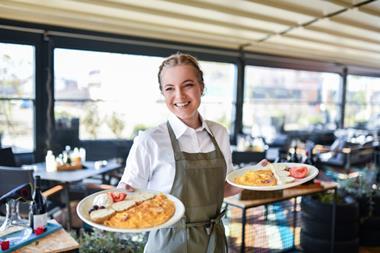Inside Track by Peter Martin
Look behind the tabloid headlines of rising alcohol and junk food consumption and the Family Food survey produced by the Department for Environment, Food and Rural Affairs provides a far more interesting picture of the country’s changing eating habits.
The underlying story for the out-of-home market is that alcohol sales in bars and restaurants actually fell last year, while the long-term boom in eating out is showing signs of cooling.
Expenditure on food out-of-the home grew just 1.6% between 2003 and 2004, compared to 3.3% the year before, hinting that the long-term growth trend might be levelling out. Eating-out now accounts for a third of all food expenditure.
The big media news from the report, which monitored the habits of 16,965 people in 7,048 UK households between 1 April 2003 and 31 March 2004, was that alcohol purchases for home consumption leapt 9% in the year.
Accompanying that was a 5.5% fall in volume sales, and a 3.3% drop in value terms, of alcohol out-of-the-home. Pubs, in fact any wet-led business, should be concerned. This looks more than a blip, but a significant and steady long-term trend, following a 4% fall the year before.
Being dependent on alcohol sales looks an increasingly unsustainable business model for all but a few. The media hysteria around binge drinking and the Government and police determination to crack down on drink abuse only adds to the pressure.
Diversifying into food would seem the obvious solution for traditional pubs, but that may well prove an over simplistic solution, especially if the overall eating-out market is slowing. It is already a competitive market.
Appreciating the nuances of the eating out market will become even more important. Perhaps it is time to take a closer look at general food retailing and how the likes of Tesco varies its offerings for specific markets and day-parts?
A couple of other insights to come from the report is that the 50 to 65 age group is second only to the under 30s in being the biggest spenders on eating and drinking out, and that children are the biggest deterrent to eating-out. The more children in a family, the less likely it is to go out to eat.
The other shock headline from the report was that the British remain junk food junkies. Most papers seized on the fact that fruit and vegetable purchases were 1.6% lower than the year before, despite the fact that the report said this fall was not statistically significant.
The true picture is that the balance of what we eat is changing, with more convenience foods consumed. The overall effect appears to be generally neutral on the healthiness of the country’s diet. Worrying for the Government is that the longer term trend towards healthier eating may now be stalling. This is something politicians will pounce on.
However, concentrating on the eating-out market, especially the fast food chains, would be the wrong target. The report shows that the out-of-home market has seen an increase in salads sold and a decrease in ice cream and sandwich sales, for example.
But most significantly, food consumed out-of-the-home accounts for just 9% of the nation’s energy and nutrient intake. Picking on McDonald’s might be highly emblematic, but it won’t change the health of the country.
Defra’s Family Food survey is one of the most comprehensive and important pieces of data for the food and drink market. It reinforces a lot of what the market already believes, but reminds that good research can also throw out some less obvious insights.











































